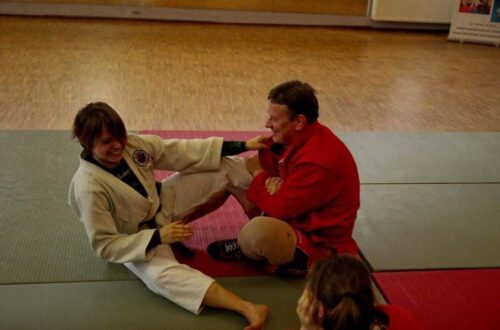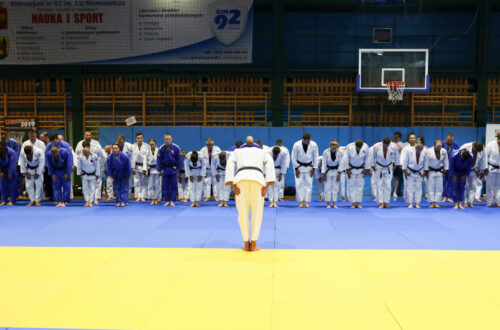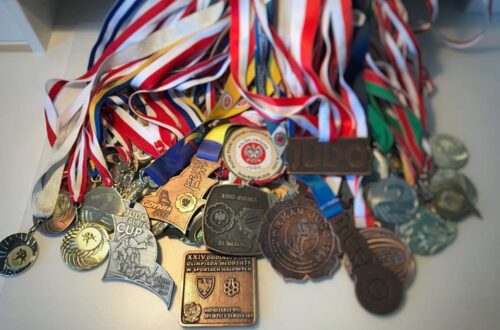
Ból jest jak duchy… przeważnie|Pain is like ghosts … mostly
Są jak najgorszy koszmar. Biją na głowę Egzorcyzmy Emily Rose. Straszniejsze niż Freddy Krueger. Bardziej przerażające nawet niż niezapowiedziany kolos z biomechaniki.
Kontuzje.
Każdy kto uprawia czynnie sport musi się liczyć z tym, że w końcu coś się popsuje.
To może być wynik nieuwagi lub braku odpowiedniej rozgrzewki. Może być również efektem przetrenowania i braku regeneracji.
Bo widzisz… nikt nie jest terminatorem (poza samym terminatorem).
Trenuję od wielu lat. W ciągu nich borykałam się z wieloma kontuzjami. Większymi lub mniejszymi. Niektóre utrudniły mi funkcjonowanie na tyle, że musiałam odpuścić intensywny trening. Inne sprawiły, że słowo „rehabilitacja” nabrało dla mnie nowego znaczenia.
Tymczasem ciało to w przypadku trenera narzędzie pracy, więc należy o nie dbać. Mój sensei wtłacza mi to do głowy od dłuższego czasu. Powtarza to przy każdej możliwej okazji, i słusznie.
Niesamowicie istotne słowa dla kogoś tak nienormalnego jak ja. Tym bardziej, że moją dewizą do niedawna było „każde złamanie da się rozchodzić”.
Otóż… nie każde, jak się okazuje.
Zanim zaczniesz walczyć, naucz się leczyć. Jeśli chcesz trenować efektywnie, bezpiecznie i długo to musisz sobie uzmysłowić jedną ważną rzecz – należy trenować z głową i dbać o siebie.
Co to oznacza w praktyce?
Wzmacniaj mięśnie i cały aparat ruchu
Kiedy masz słabe mięśnie, polegasz jedynie na stawie, aby dźwigał cały ciężar. To jest katastrofa. Należy wzmacniać mięśnie podtrzymujące strukturę stawu. To na nich należy polegać zarówno jeśli mówimy o stabilizacji jak i efektywnym i bezpiecznym treningu.
Wzmacniać mięśnie i resztę całej aparatury możesz na różne sposoby. Można ćwiczyć w domu z Chodakowską, można biegać, iść na fitness i poskakać w rytm muzyki.
Zadbaj o znaczny zakres ruchu
Niektórzy uważają, że rozciąganie jest rozwiązaniem, ale to zdecydowanie za mało.Widzisz, prawdziwym problemem nie jest elastyczność … ale mobilność! Mobilność to zdolność poruszania stawem poprzez pełen zakres ruchu. Można nazwać to „aktywną” lub „dynamiczną” elastycznością. Nie skracajmy ruchów, nie wypaczajmy technik, nie zadowalajmy się połową skuteczności.
Pozostań aktywny i zdrowo się odżywiaj
Nie trzeba trenować wyczynowo by zachować zdrowie (poza tym są różne opinie na temat jego wpływu na zdrowie). Można trenować rekreacyjnie. Jazda na rowerze sprawia Ci przyjemność? To do dzieła! Lubisz pływać? Bierz ręcznik i leć na basen! To wcale nie muszą być sztuki walki – choć ja nie wyobrażam sobie życia bez nich.
Dobrze zbilansowana dieta, w której zawrzesz wszystkie potrzebne elementy to podstawa zdrowia. Białko, węglowodany i tłuszcze… Należy się zapoznać z tymi słowami i zainteresować odpowiednimi proporcjami.
Odpoczywaj i regeneruj się
Odpoczynek jest ważnym elementem cyklu treningowego z kilku powodów: pozwala uniknąć przetrenowania oraz kontuzji, której ryzyko wzrasta gdy organizm jest przeciążony; pomaga w odzyskaniu sił i motywacji potrzebnych do dalszych treningów; przyczynia się do efektu tzw. superkompensacji. W ten sposób stopniowo poprawia się nasza wydolność i za każdym razem możemy uzyskiwać lepsze wyniki sportowe. Czasem wystarczy ciepła kąpiel i długi sen, a czasem potrzebny jest masaż lub rolowanie. To zależy od Twojego organizmu i jego potrzeb. Niektórzy potrzebują jedynie zimnego piwa (które wbrew pozorom dobrze nawadnia po ciężkim treningu) i odpowiednio zbilansowanego posiłku by czuć się jak młody bóg.
A w przypadku gdy borykasz się z jakąś kontuzją…
Oszczędzaj uszkodzoną część ciała
Skoncentruj się na łatwiejszych wersjach technik, które zwykle powodują dyskomfort, bądź też wykonuj mniej powtórzeń lub rób je wolniej. Potraktuj to jako krok ku usprawnieniu. Jeśli przesadzisz to będziesz później cierpiał. Zdrowy rozsądek to najlepszy przyjaciel każdej osoby aktywnej fizycznie.
Nie chojrakuj.
Poświęć dłuższą chwilę na jej rozgrzanie i przygotowanie do treningu
Przed treningiem dokładnie rozgrzej kontuzjowaną część ciała. Standardowa rozgrzewka to może być za mało. Potrzebujesz dłuższego czasu.
Na przykład; jeśli kopanie powoduje pewien dyskomfort, spróbuj rysować małe kółka stopą. Obrót w Twoim biodrze przygotowuje Cię do większego zakresu ruchu. Następnie wykonaj wymach nogą po większym łuku. Następnie delikatnie kopnij.
Zabezpiecz ją przed kolejnym urazem
Istnieje kilka narzędzi, które możesz wykorzystać do wspierania swoich stawów, mięśni czy więzadeł. Stabilizatory, ortezy, elastyczne ściągacze a czasem nawet zwykły bandaż czy tapy pomogą ustrzec uszkodzone tkanki przed kolejnym urazem i niepotrzebnym bólem. Stabilizują, utrzymują odpowiednią temperaturę i przypominają o potrzebie zachowania kontroli.
Wykorzystaj je.
Zwracaj uwagę na prawidłową technikę na treningu
Zawsze zachowuj właściwą postawę podczas wykonywania swoich technik i dbaj by były one nienaganne technicznie. Wbrew powszechnej opinii, właściwa technika nie dotyczy estetyki. Chodzi o funkcję! Zapewnia bowiem stabilność i nie narusza integralności stawu. W momencie, gdy o tym zapominasz powodujesz niepotrzebne obciążenia, które pogarszają ból.
Jeśli jesteś zbyt zmęczony, aby utrzymać prawidłową technikę i ból się nasila poproś o pozwolenie na przerwę.
Dobry trener zrozumie. Okaże Ci również wsparcie.
Słuchaj fizjoterapeuty oraz trenera
Może się to wiązać ze zmianami w programie czy sposobie treningu. Radzenie sobie z kontuzjami wymaga niekiedy korekty regularnego treningu. Oznacza to, że potrzebujesz dialogu ze swoim sensei – najlepiej też porozumieć się z lekarzem lub fizjoterapeutą, aby wszyscy byli po tej samej stronie.
Ponieważ zaufaj mi – będziesz musiał zmienić swój trening.
Lub ponosić konsekwencje.
Rehabilituj
Ból nie jest wcale dobrym materiałem na przyjaciela. Chroniczny ból to już zdecydowanie wróg numer jeden. Może zabić radość praktykowania. Dlatego należy z nim walczyć. Być może potrzebna jest kompleksowa fizjoterapia. Może laser, może krioterapia czy jonoforeza.
A może trzeba zaopatrzyć się w specjalną ortezę czy stabilizator i maści przeciwzapalne czy rozgrzewające?
Ja mam zestaw małego kaleki zawsze przy sobie. To żaden wstyd.
Nie poddawaj się
Walka z kontuzjami podczas treningu może być przygnębiająca. Zmiana sposobu treningu również może być frustrująca.Nie spoglądaj wstecz na czasy, kiedy ćwiczyłeś intensywnie bo nie ograniczał Cię ból. Wykorzystaj to jako okazję, aby Twój trening ewoluował w coś innego, bardziej wyrafinowanego.
Wykorzystaj walkę ze swoimi słabościami jako źródło satysfakcji. Dasz radę, nie poddawaj się.
To duch budo.
Tak na koniec już… Powinieneś nauczyć się odróżniać ból uszkodzonych tkanek od palenia mięśni po świetnym treningu. Ja zwykłam mówić, że taki „ból” jest jak duchy.
Niektórzy w nie wierzą.
#trening #sztuki_walki #kontuzje
They are like your worst nightmare. They beat Emily Rose’s exorcism. Scarier than Freddy Krueger. More terrifying even than the unannounced colossus of biomechanics.
Injuries.
Anyone who actively practices sport must take into account that eventually something will break down.
This may be the result of inattention or a lack of proper warm-up. It can also be the result of overtraining and lack of regeneration.
Because you see … no one is a terminator (except the terminator itself).
I have been training for many years. During them I struggled with many injuries. Bigger or smaller. Some of them made my functioning difficult enough that I had to give up intensive training. Others made the word „rehabilitation” take on a new meaning for me.
Meanwhile, the body is a work tool in the case of a trainer, so it should be taken care of. My sensei has been stuffing this into my head for a long time. He repeats this whenever possible, and rightly so.
Extremely essential words for someone as insane as me. The more that my motto until recently was „every break can be spread.”
Well… not all, as it turns out.
Before you start fighting, learn to heal. If you want to train effectively, safely and for a long time, you need to realize one important thing – you should train wisely and take care of yourself
What does this mean in practice?
Strengthen your muscles and the entire motor apparatus
When you have weak muscles, you only rely on the joint to carry all the weight. This is a disaster. The muscles that support the structure of the joint should be strengthened. You should rely on them both when it comes to stabilization and effective and safe training. You can strengthen your muscles and the rest of the equipment in different ways. You can exercise at home with Chodakowska, you can run, go to fitness and jump to the rhythm of the music.
Make sure you have a considerable range of motion
Some people think stretching is the solution, but it’s definitely not enough. You see, the real problem isn’t flexibility … but mobility! Mobility is the ability to move a joint through its full range of motion. This can be called „active” or „dynamic” flexibility. Let us not shorten the movements, let us not distort the techniques, and let us not be satisfied with half the effectiveness.
Stay active and eat healthy
You don’t have to train competitively to stay healthy (and there are different opinions about its effects on health). You can train recreationally.
Do you enjoy cycling? Let’s go! You like swimming? Get a towel and go to the pool!
They don’t have to be martial arts – although I can’t imagine my life without them. A well-balanced diet, which includes all the necessary elements, is the basis of health. Protein, carbohydrates and fats … You should read these words and be interested in the right proportions.
Rest and regenerate
Rest is an important part of the training cycle for several reasons: it allows you to avoid overtraining and injury, the risk of which increases when the body is overloaded; helps in regaining strength and motivation needed for further training; contributes to the effect of the so-called supercompensation.
In this way, our efficiency gradually improves and we can achieve better sports results each time. Sometimes a warm bath and a long sleep are enough, and sometimes a massage or rolling is needed. It depends on your body and its needs. Some people only need a cold beer (which, contrary to appearances, hydrates well after hard training) and a properly balanced meal to feel like a young god.
And in case you are struggling with an injury…
Save the damaged part of the body
Concentrate on the easier versions of the techniques that usually cause discomfort, or do fewer or slower repetitions.
Take it as a step towards improvement. If you overdo it, you will suffer later. Common sense is the best friend of any physically active person. Don’t be silly and chill out.
Take a moment to warm it up and prepare it for training
Before training, thoroughly warm up the injured part of the body. A standard warm-up may not be enough. You need a long time.
For example; if kicking causes some discomfort, try drawing small circles with your foot. The rotation of your hip prepares you for a greater range of motion. Then swing your leg over a larger arc. Then gently kick it.
Secure her against another injury
There are several tools you can use to support your joints, muscles and ligaments. Stabilizers, orthoses, elastic cuffs and sometimes even a regular bandage or tapes will help protect damaged tissues from further injury and unnecessary pain. They stabilize, maintain the right temperature and remind you of the need to maintain control. Use them.
Pay attention to the correct technique in training
Always maintain proper posture when performing your techniques and keep them technically impeccable. Contrary to popular belief, the right technique is not about aesthetics. It’s all about the function! It ensures stability and does not affect the integrity of the joint. The moment you forget it, you create unnecessary burdens that make your pain worse.
If you are too tired to maintain proper technique and the pain is getting worse, ask for permission to take a break.
A good coach will understand. He will also show you support.
Listen to the physiotherapist and trainer
This may be related to changes in the training program or method. Dealing with injuries sometimes requires regular training adjustments. This means that you need a dialogue with your sensei – and it’s best to talk to your doctor or physical therapist so that everyone is on the same side. Because trust me – you will have to change your training. Or face the consequences
Rehabilitate
Pain is not a good friend at all. Chronic pain is definitely enemy number one. It can kill the joy of practicing. Therefore, it must be fought against. Perhaps you need comprehensive physical therapy. Maybe a laser, maybe cryotherapy or iontophoresis. Or maybe you need a special orthosis or a stabilizer and anti-inflammatory or warming ointments?
I always have a set of a cripple with me.
It’s no shame.
Do not give up
Struggling with injuries while exercising can be disheartening. Changing the way you train can also be frustrating. Don’t look back at times when you were exercising intensely because you were not constrained by pain. Use this as an opportunity to make your training evolve into something different, more sophisticated. Use fighting your weaknesses as a source of satisfaction. You can do it, don’t give up.
It’s the spirit of budo.
So finally… You should learn to distinguish between pain in damaged tissue and burning muscles after great training. I used to say that such „pain” is like ghosts.
Some people believe in them.





